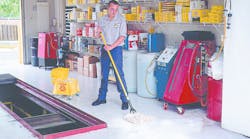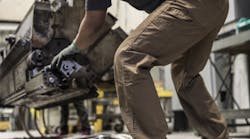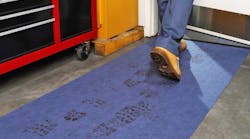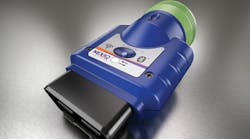Shop floor cleanliness is a necessity for many reasons. A chief one being: it provides a safer working environment.
However, keeping floors clean is a challenge, say officials with Kafko International (www.kafkointl.com), a full-range packager of automotive, household and specialty chemical products. They note that very few people enjoy cleaning and most tend to put it off as long as they can and then complain about how hard it was to do.
To lessen the burden of floor cleaning, the company has come up with its Oil Eater’s Clean as You Go procedures to help ensure that shop floors stay relatively clean and employees and customers will see a neat and polished facility. The procedures includes these floor cleaning do’s and don’ts.
Do
- Pick up drips and spills immediately to prevent tracking the matter through the shop.
- Put the minimum amount of cleaning solution needed in a mop bucket.
- Change the cleaning solution after mopping each bay.
- Hang mops when not in use.
- Empty and clean mop buckets after each use.
Don’t
- Leave mop buckets filled with dirty solution.
- Leave a mop in the mop bucket in the dirty solution.
- Leave drips and spills for clean up later or the next person.
FLOOR MOPPING
The procedures also provide these recommended procedures for mopping a shop floor.
1. Prep the area to be mopped.
- Place wet floor signs to alert coworkers.
- Move any equipment or furniture to a safe area where they will not be in the way and can be easily put back in place.
- Use a putty knife to remove any matter like tar or gum that is stuck to the floor.
2. Sweep the area.
3. Mop the area.
- Use a solution of eight to 10 parts water to one part cleaning solution, such as Oil Eater.
- Dip the mop in the solution and wring it out so it is damp.
The biggest problem when cleaning is over wetting the surface, note officials. A damp mop will allow the oil and dirt to cling to the mop, versus just spreading in around.
- Start in the corner farthest away from where you will finish.
- Mop in an “S” or figure 8 motion, working back from where you started. Re-dip the mop in the solution and wring it out frequently.
- Change the solution after mopping each bay.
4. Clean up
- Empty and rinse the mop bucket so it will be ready for the next shift.
- Rinse the mop completely and hang it up.
- Remove the wet floor signs.
- Put equipment and furniture back in place.
When following the Clean As You Go procedures, floor mopping should only need to be done once or twice a day, usually at the end of each shift, say the officials.




